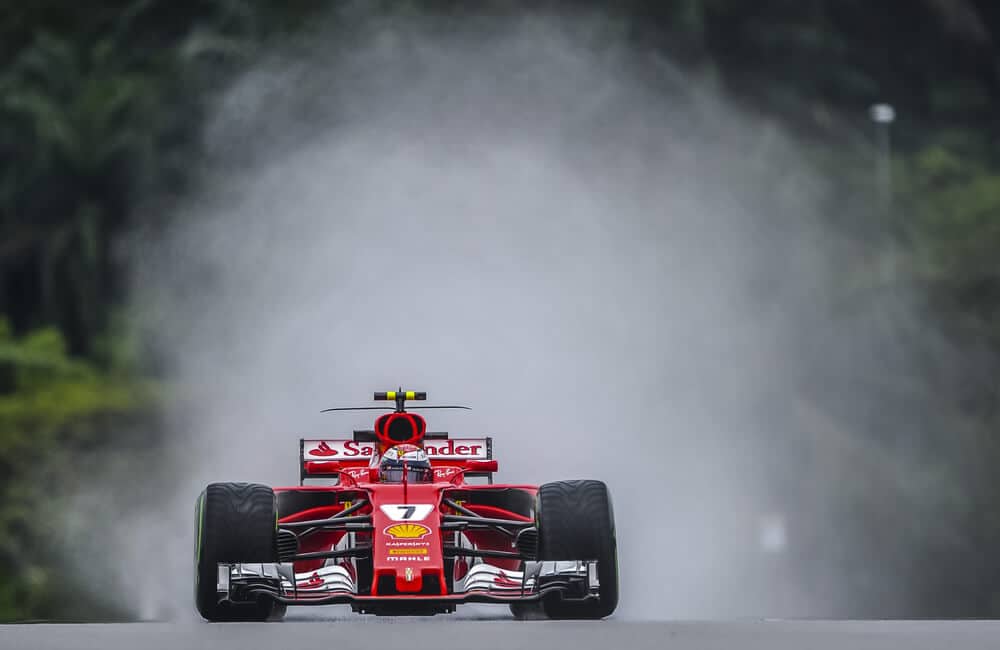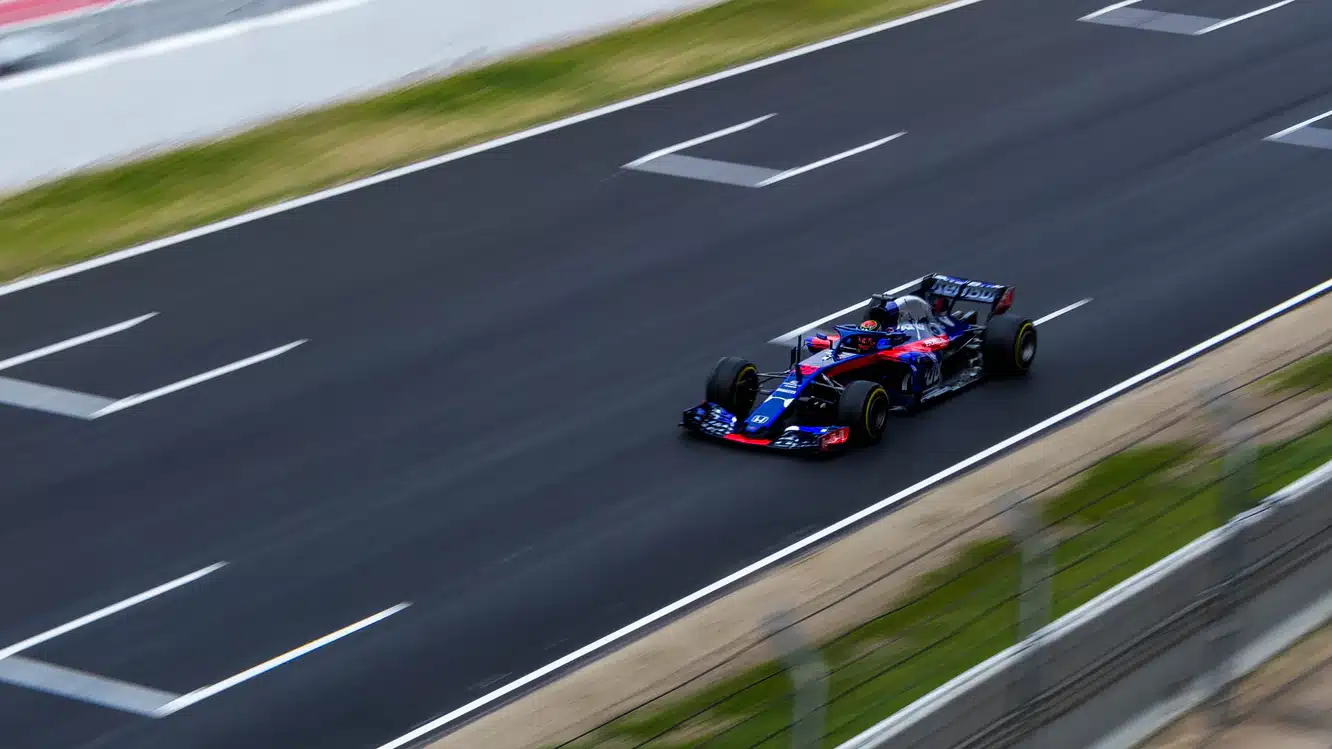Ground Effects in F1 can be simply explained as the use of low pressure underneath a car to help push it down onto the track. This technology was first used in F1 racing between 1978 and 1982 and made its unexpected return in 2022.
This concept is based on Bernoulli’s principle and the Venturi effect. When air is forced through a funnel, it speeds up as the space decreases. It then creates less pressure underneath the car, which causes the air to circulate faster. This creates a large downforce which helps stick the car to the track and increases its speed. In short, lower pressure equals higher speed and vice versa.
The idea of ground effects was to create a low-pressure area underneath the car. That generates downforce – strong enough to push it onto the track and keep it there. This creates greater stability, allowing cars to corner faster and with more control.
How Ground Effects work
If we take a look at how ground effects work in F1 racing, we can understand that this is a concept of downforce. The air is directed beneath the car in order to create an area of low pressure. This low pressure than ‘sucks’ the car onto the track and helps provide it with further grip during cornering. The man behind translating this idea into reality was Colin Chapman, the renowned founder of Lotus.
Essentially, the operation of ground effects is similar to that of an airplane’s wings but in a reversed manner. In an airplane – its wings create an airflow over the wing that is faster than under it, consequently lifting it up. With F1 cars, the floor functions as an inverted wing and causes a ‘sticking’ effect to the track rather than a lift.
Components of Ground Effects
Ground effects in Formula 1 are based on Bernoulli’s principle and the Venturi effect. Components of this aerodynamic package include venturi tunnels, diffusers, wings, and bargeboards.
Venturi tunnels are like funnels which direct the air beneath the car, making it move faster and decreasing pressure. This creates a downforce that helps stick the car to the track. Diffusers are located at the rear of the car and divert high-pressure air away from the rear of the car. It creates downforce and increasing stability.
Additionally, wings are located on the nose and rear of the car. They help to provide extra downforce by redirecting air from the top of the car. Lastly, bargeboards are located around sides of the car and also help control airflow for increased efficiency.
Impact on car performance
It’s obvious that ground effects in Formula 1 have a huge impact on the performance of cars. The low pressure underneath the car helps to create an area of downforce. It gives more grip as well as greater stability around corners and during high speeds. Additionally, this helps reduce drag and improves aerodynamic efficiency – resulting in faster lap times.
The ground effect also provides the improved cornering ability, allowing drivers to take turns with greater speed and control. This is especially beneficial in high-speed circuits such as Monaco or Monza.
Key Takeaways
Here are some key aspects that you should know regarding ground effects in Formula one:
- Ground effects in Formula 1 are based on Bernoulli’s principle and the Venturi effect.
- The concept is to create a low-pressure area underneath the car. The low pressure generates downforce – strong enough to push it onto the track and keep it there.
- Ground effects have a huge impact on the performance of cars. It provides them with more grip, stability, and reducing drag for faster lap times.
- The low pressure created beneath the car helps to provide improved cornering ability. It allowes drivers to take turns with greater speed and control.
- The operation of ground effects is similar to that of an airplane’s wings but in a reversed manner.
- Ground effects is beneficial in high-speed circuits such as Monaco or Monza.
Historical Context
Now that we know the impact of ground effects on Formula 1 car performance, it’s also important to understand its historical context.
Ground effects are not a new concept in the world of Formula 1. It was first popularised by Colin Chapman of the Lotus team in 1978 when they developed and raced a car that used the technology to create high cornering speeds which resulted in great success for them.
Key Innovations in Ground Effects
As we mentioned before, ground effects were first popularized by Colin Chapman and the Lotus team in 1978. This innovation was far superior to other cars at the time and quickly spread throughout the competition.
The Lotus 78 debuted in 1977 and tripled downforce levels compared to other cars on the grid. A combination of unreliability and rivals trying to understand their innovation meant they could not win the world championship that year.
The success of the Lotus 78 led to improvements for the next model. With the debut of the Lotus 79 in 1978, Mario Andretti was able to win the driver’s title and Lotus the constructor’s championship.
The success of ground effects technology meant it spread throughout other teams like Ligier and Williams. They further improved on it with Alan Jones winning the 1980 title in his ground-effect FW07 car. Despite their innovative design, Lotus was unable to win any other titles with their ground-effect cars. This meant that this aerodynamic device was getting stronger and stronger.

The “Golden Era”:
The introduction of ground effects in late 70’s marked a new era in Formula 1 racing. As we mentioned, the Lotus 78 took ground effects to a whole new level and its successor, the 79, was even more successful.
It created 200 pounds of downforce from its rear wings and 100 pounds from the front when traveling at 150mph. It was an impressive figure compared to other cars on the grid.
The ‘golden era’ of F1 was defined by Lotus 79, and other teams such as McLaren and Brabham had to catch up with their own innovations like the BT46B – a gargantuan rear fan designed to pull air up from underneath the vehicle. Despite initial success, the fan was banned after only one race.
The era eventually ended in 1982 with new regulations enforced by the FIA, banning cars from having flat undercarriages. But now, 40 years later, we saw the return of ground effect aerodynamics – and it’s sure to be even more impressive than before!
Challenges and limitations
Although the introduction of ground effects revolutionized the sport, its use came with many challenges and limitations. This is one of the reasons why they were eventually banned by the FIA.
Safety Concerns
The use of ground effects in Formula 1 was revolutionary, however, it came with several risks. The FIA made the decision to ban them for safety reasons in 1982 due to the accidents that had occurred as a result of their use. Drivers like Ronnie Peterson, Patrick Depailler, and Gilles Villeneuve all tragically lost their lives in accidents caused by ground effects.
Skirts were introduced to contain air pressure underneath cars, however, they could often lift up due to irregularities on the track, making cars unstable and difficult to control. René Arnoux’s car went airborne and nearly crashed into the crowd in 1980, and Didier Pironi’s car did the same when it collided with Alain Prost’s Renault in 1982. After this, it was clear that something had to be done for improved safety standards in Formula 1 racing.
From 1983 onwards, skirts were prohibited, and instead, cars had to have a completely flat bottom to reduce downforce and therefore avoid the risk of them going airborne. The cars were no longer as fast in the corners, but safety was significantly improved.
Recent developments
The above discussion on ground effects in Formula 1 gave us an overview of its use and challenges associated with it. Now one must wonder why it made a return if it was banned in 1982, citing safety concerns.
Let’s take a look at the new regulations for 2022 and beyond regarding the use of ground effects in Formula 1.
Technological Advances
Ground effects in Formula 1 were banned in 1982 due to safety concerns, but with modern advancements and technological advances, they have made a comeback.
The updated regulations for 2022 and beyond seek to keep safety a priority by prohibiting the iconic skirts of the 80s, instead implementing small aerodynamic elements on the sides that help seal the underfloor.
Additionally, modern circuits are much safer than those in the past, with numerous run-offs and safety barriers, plus a wooden plank on every car’s floor to ensure downforce is not suddenly lost if a driver hits a bump or pothole. The floor is also smoother and more progressive, designed to generate downforce through ground effect rather than wings.
Future of Ground Effects in F1
After being banned in 1982, ground effects are now back in Formula 1 and fans are eager to see what the future holds. In spite of the fact that the return of ground effect made it uncomfortable for drivers due to the “porpoising” effect, technology advancements and safety measures should minimize the risks.
The return of ground effects will require a new approach to car design, as teams will need to balance speed and downforce with driver safety. The porpoising effect mentioned earlier is just one example of the challenges drivers will face, as they must maintain control of the car at high speeds while dealing with changes in altitude and balance.
It is inevitable that teams and drivers will have a learning curve as a result of this new technology or design approach. To create safe, effective ground effects in F1 cars, it will take time to develop and refine the technology. But as in the past, F1 will rise to the challenge and continue to push its boundaries.
Frequently Asked Questions
Ground effects in Formula One refer to the aerodynamic phenomenon where a car’s body is shaped in such a way as to create a low-pressure zone underneath the car, which generates downforce and improves cornering speeds.
By generating downforce through the use of carefully designed aerodynamic features, ground effects help to increase a car’s grip on the track, allowing it to corner at higher speeds and with greater stability. This contributes to increased overall performance.
Ground effects were banned in 1982 siting safety concerns which saw some serious incidents. However, with its return to F1 in 2022 it is hoped that such incidents won’t be repeated with the new technological advancements and regulations.



